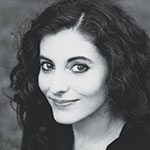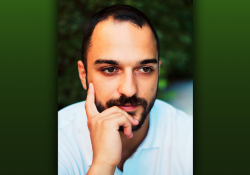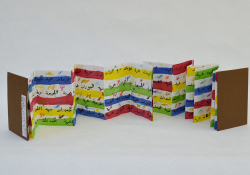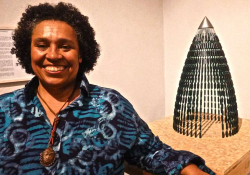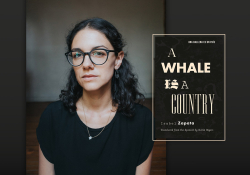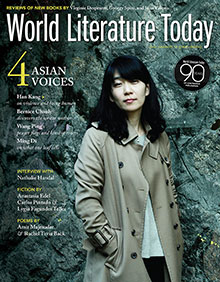“Building an Architecture for the Wanderer”: A Conversation with Nathalie Handal
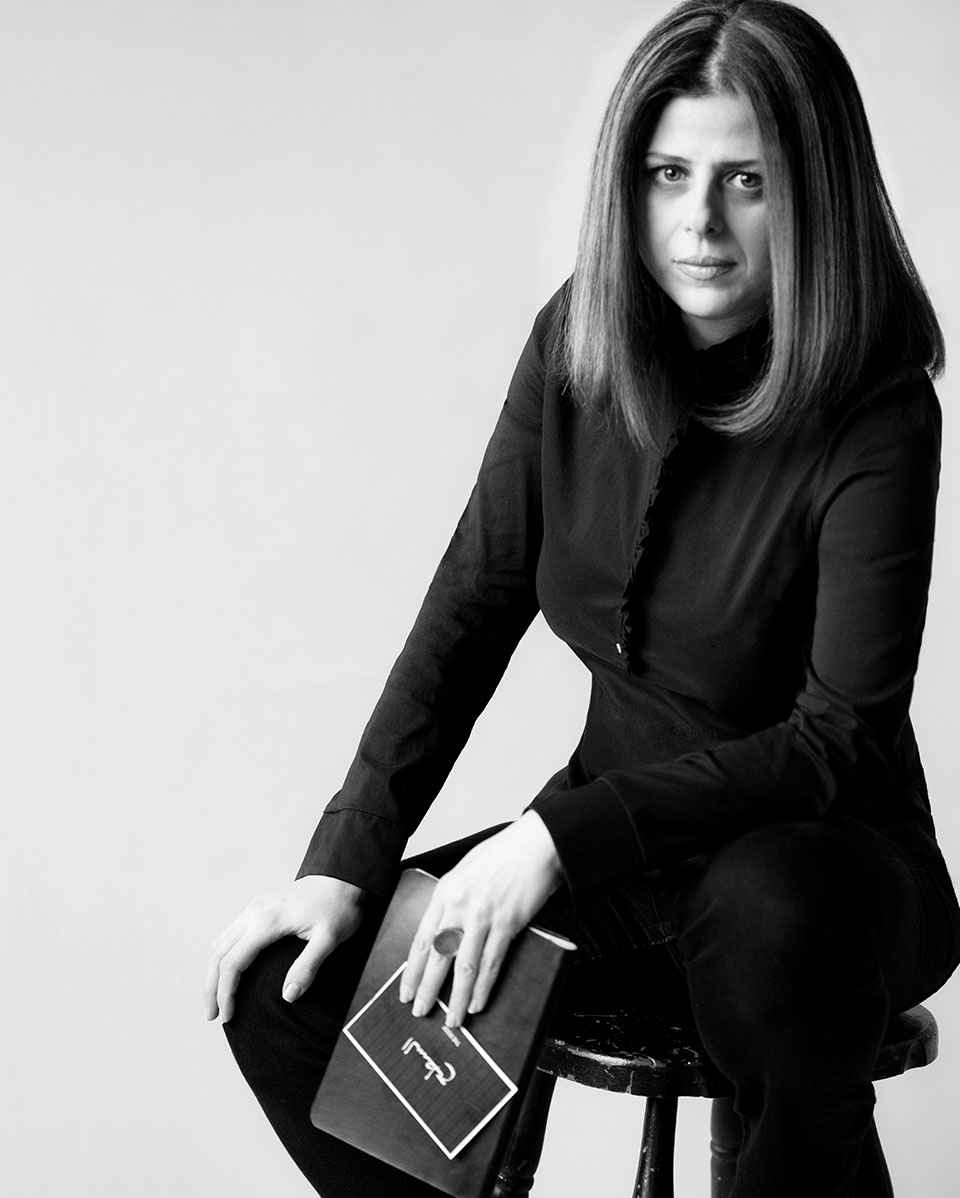
Groundbreaking poet, playwright, and editor Nathalie Handal is one of our most diverse contemporary writers, and as the Washington Independent Review of Books writes, it’s with “startling force [that she] is building an architecture for the wanderer.” Her many honors include being a Lannan Foundation Fellow, the winner of the Alejo Zuloaga Order in Literature, and an Honored Finalist for the Gift of Freedom Award. Raised in Latin America, France, and the Arab world and educated in the United Kingdom and the United States, the award-winning writer now lives in New York City. She is a professor at Columbia University and curates the literary travel column “The City and the Writer” for Words Without Borders magazine.
We sat down this past December at the Hungarian Pastry Shop in Manhattan, shortly before Handal’s poem “Lady Liberty” was to appear on posters in New York City subways, buses, taxis, and on MetroCards as part of Poetry in Motion, a joint project of the MTA Arts for Transit & Urban Design and the Poetry Society of America, whose featured poems are read by more than seven million commuters daily. Our conversation—about the progression of Handal’s work, the influence of speaking so many different languages on her English, and her personal and literary connections—concluded over tea and Middle Eastern snacks in January at Montreal’s Café L’Insouciant.
Rachel Morgenstern-Clarren: Your books are written in English but laced with Arabic, French, Spanish, Italian, Creole, and even Russian and Sanskrit words. Given your fluency in so many languages, why did you decide to write primarily in English? How do you think that impacts what and how you write?
Nathalie Handal: I didn’t choose it. English just came to me, and I welcomed it. It doesn’t impact what I write. My work would be about a search for connectedness no matter what language I wrote in. The more languages you know, the more unique and complex your own language becomes.
RMC: What languages did you speak growing up? Did you ever consciously learn a language, or do you consider all of them to be your hyphenated “mother tongue”?
NH: I’ve often said I don’t have a mother tongue. In fact, they are all hyphenated mother tongues. Together they create a symphony, a new language, and the multiplicity of that new language reflects my identity and life.
RMC: Has your work been translated into other languages? Which language would you most like to be translated into in the future?
NH: My work has been translated into fifteen languages. There isn’t a language that I’d most want to be translated into—they all intrigue me, and it’s a gift to expand the conversation. But I would like to be retranslated into all the languages I’ve previously been translated into. I now have a deeper understanding of the fundamental importance of translating culture alongside the words themselves. I would like to work with translators who have an understanding of the multiplicity of cultures present in my work—the nuances and localisms, rhythms and beats, histories and idiosyncrasies—in order to better translate it into whatever the equivalent would be in their own language and culture. Still, I’m aware that at certain levels translation is impossible, and equivalents don’t exist. But a proximity—textually, musically, and emotionally—would be wonderful.
RMC: When did you start writing?
NH: My mother told me that I’ve always been inquisitive, that my favorite questions growing up were: What happened? Then what happened? And after that, what happened?
Language is mysterious—that pleased my curious nature as a child, my desire to explore the way imagination dares us, and my deep belief that pleasure is a fundamental agent of creation as well as a healing one.
Not long ago, my father told me that in my early teens I asked him if working in the United Nations would take me around the world. He then added, You always wanted to go far. It wasn’t distance but freedom that I was seeking. I’ve never been able to follow convention in any aspect of my life.
RMC: Do you remember what your first stories/poems were about?
NH: My first stories and poems were about exile, its convolution, and how that impacted who I was and what I would become. What makes loss bearable is that love is there, too.
RMC: Who were your favorite writers when you were growing up?
NH: I distinctly remember the wildly stunning energy that moved through me when I read Les Fleurs du mal, by Charles Baudelaire; I fell in love for the first time, realizing that words were going to be my lifetime partners. After reading Bonjour Tristesse, by Françoise Sagan, I was so moved that I couldn’t finish reading the novel. Then I read it again and again. I, too, wanted to invent stories that took people to places beyond what they knew, to offer them a chance to encounter places and people they might have previously judged (as the stories and characters that often interest me are the most marginalized). And Mahmoud Darwish’s work has been home, salvation, and hope—the opposite of what I inherited from loss.
RMC: Did you always know that you were a poet? When did you decide to pursue poetry “professionally”?
NH: Poetry is a mystical and magical experience—it doesn’t come from what we know. The only time I feel whole is while writing. Along the way, I met mentors who helped me clarify to myself that wanting to spend a life with the page wasn’t such a crazy idea—they had the same impulse. Derek Walcott told me in my early twenties, and his words resonated with my nomadic spirit, “Do whatever you have to do to write; don’t settle in a job.”
Lucille Clifton made me understand the generous power of poetry. She also taught me how to put a poetry book together when I took a workshop with her in London. I still remember her luminous face as she placed my poems on the floor and asked me how they spoke to one another. Gerald Stern, at a Poetry Society of America event on black iconic poets of the twentieth century that we both participated in, said, “Clifton is our prophet.” I agree.
The first poems I ever published appeared in the British magazine Ambit, with the enthusiastic support of John Burnside. It took me nearly twenty years to cross paths with John and tell him that his support meant so much to me that it nearly eliminated the bloody rejections that writers are all too familiar with.
I’ve always been dedicated to my craft. Earlier on, I was only thinking about the page, not the rent, the endless bills and headaches that slowly tiptoed behind me and for which I had no solution. So if your question is, when did I connect poetry in any way with income, I would say, when I moved to the United States in my early thirties. I was studying Irish and Russian literature at the University of London, and on one of my trips to St. Petersburg, I met Phillip Lopate at the Akhmatova Museum. He was reading a very particular essay about a very private part of his body. I felt like I was in a Woody Allen movie. Intrigued, I wanted to know more about him. He ended up encouraging me to get an MFA in creative writing, which I didn’t know anything about. Being in Europe at the time, such programs were nearly nonexistent. I welcomed the adventure, though, and that’s how my publishing life began.
I eventually met Ed Ochester, who believed in my voice and made space for me in the American mainstream. That changed everything. I’m forever grateful.
RMC: You hold an MFA in creative writing from Bennington College. What was that experience like? Did you have any writing mentors, or classmates, who were particularly influential on your later work/career?
NH: Bennington College showed me that one could practice the art of poetry in the larger world, and it introduced me to American poetry and its literary scene. The two most important influences from my Bennington days were Jane Hirshfield, for her poetic intelligence, quiet and precise, and Ed Ochester, for teaching me how to enter the mind of poetry.
As for influences that came later on, there were many. Irish literature has always captivated me, but I discovered Joseph O’Connor later on. His work moves me deeply. Julio Cortázar’s Hopscotch is masterful. Octavio Paz’s The Double Flame: Love and Eroticism is thought-provoking. Anything by Italo Calvino, James Baldwin, Dany Laferrière, Lydia Davis, and Marilynne Robinson. The fierce voices of Sapphire, Adrienne Rich, Alice Walker. There are many more, of course.
But when it comes to writing, the best teacher has been the room—practicing silence, reading, writing, being disciplined.
RMC: Where have you lived? In Poet in Andalucía, you write that “my own longing stretches across four continents.” Longing—for cities, for people, for language, for the past, for a homeland—permeates your poetry. Which cities have been the most important to you, personally and poetically?
NH: The list is too long. And most importantly, I’ve never lived in just one place. I’ve always divided my time between multiple places. I am very much an urban person—Paris, New York, and London are my cities. My ancestral cities of Bethlehem-Jerusalem are places my heart cannot be without; Jaffa, a place I deeply long for. Latin America fuels my imagination in intricate and stimulating ways. Asia fascinates me and pulls at me more and more. And the Mediterranean—Italy, Greece, Spain, the south of France—fills a deep void, and makes me blissful.

RMC: Tell me a little bit about growing up in Haiti and why you eventually left.
NH: I was in Haiti for close to a decade, from the age of seven until Baby Doc fled in 1986 and the political situation became increasingly turbulent. However, in Haiti and in all the numerous cities we lived in, the moment I entered my family house, I entered Palestine, and more specifically Bethlehem-Jerusalem. We were surrounded by Palestinian artifacts and images, listened to Arab music, ate Arab food, spoke about the conflict, and were consumed by the scars and the elation it left inside of us—our sense of self deeply rooted in the Holy Land, the dream of return sacred. While growing up in Haiti, I also spent time in Mexico, where a large part of my family was in exile, and in France, which has never ceased being a home.
In Haiti and in all the numerous cities we lived in, the moment I entered my family house, I entered Palestine, and more specifically Bethlehem-Jerusalem.
When I think about my time in Haiti, three things come to mind: the paintings aligned on the streets, sidewalks like universes of inexhaustible colors that even darkness can see lucidly; studying by candlelight while listening to gunshots outside, and forcing the fear to inspire me, realizing that one of the greatest beauties lies in the freedom a nation seeks; and the wisdom revealed to me by three special Haitian women: Lucy—that love is quiet; Anita—that laughter despite misery is the uniting force of the soul; and Rosanna—that silence is a hymn.
RMC: Working with Writers Bloc, “a writer-led initiative to explore and discuss the challenges faced by educators and students internationally,” why did you choose to go to Haiti?
NH: Writers Bloc, led by Zadie Smith, Rachel Holmes, Kamila Shamsie, Nick Laird, and Hari Kunzru, sponsored by the Open Society Foundations with Hugh McLean as the instigator of the project, commissioned ten authors to write about education in a developing country through a personal lens. They were published in various well-known magazines such as Guernica. I chose Haiti because I had not gone back for over twenty years, except for two short visits in the 1990s.
RMC: Did you write the poems in The Republics while you were still in Haiti and the Dominican Republic, the way you wrote about Spain in just nine months for Poet in Andalucía, or did you have more distance from your travels while working on this new collection? You write in the endnotes that The Republics “began as a personal account of my relationship to the island of Hispaniola—Haiti and the Dominican Republic—and moved to the voices I encountered because they were louder than mine.” How did you initially envision the project, and how did it change once you actually got there?
NH: For Poet in Andalucía, I had a blueprint—recreating Federico García Lorca’s journey in reverse. I wanted to be in dialogue with Lorca’s Poet in New York, to explore convivencia or coexistence while the past and the present conversed. I didn’t have a vision or plan for The Republics. It just happened. Months after I returned from Haiti, the voices I had heard there kept coming back to me. I had audio recordings and notebooks filled with accounts of the earthquake. I shared my experiences with Carolyn Forché. She called me a “bridge poet,” and that unlocked something inside me. I allowed the voices to translate themselves on my pages. They surprised me—they were story-driven, and they came in prose form (see WLT, May 2014, 12–13).
RMC: In your previous collections, you experiment with various forms, such as qi’tas, ghazals, tzvis, and zajals. How would you describe the “flash reportages” or “semi-témoignages” form in The Republics?
NH: I write in multiple voices, so it seems natural to me that the forms I experiment with vary, too. The voices need different houses. The pieces in this collection are somewhere between prose poetry and flash fiction. But since they are loosely based témoignages, flash reportages seem more precise to me.
RMC: Do you have any writing routines?
NH: On the road—which I’m on incessantly—I jot down notes, or write in my mind. I ponder, plan, ruminate some more. Then when I return to my apartment, or wherever I am residing at the moment, I wake up early and write all day.
RMC: Do you have a favorite writing spot, or setup, that you like to return to?
NH: My favorite place to write is in my apartment. I have gone to some residencies and felt deeply inspired, like at the Lannan Foundation residency in Marfa. The energy in the house they gave me was electric and peaceful. The landscape, too—the desert stirs my spirit.
RMC: How does your role as a teacher of creative writing and literary translation inform your role as a poet and translator?
NH: They are in dialogue with each other. I have been translating culture, identity, and text all my life. Besides my own writing, it was natural to engage with the world through other literary practices such as those you mention. It’s more than a literary engagement; it’s also a sociopolitical one, one that brings awareness and is rooted in nonviolence. Literature can help dismantle stereotypes, which are uninventive labels, harmful and dehumanizing.
I do not teach young poets how to write poetry, but rather how to get to poetry. I teach them how to listen and read, and from that vantage point, I hope that they find their voices.
I do not teach young poets how to write poetry, but rather how to get to poetry. I teach them how to listen and read, and from that vantage point, I hope that they find their voices.
RMC: In addition to being a poet, playwright, and teacher, you’ve edited (or co-edited) two landmark anthologies: The Poetry of Arab Women and Language for a New Century: Contemporary Poetry from the Middle East, Asia and Beyond. What inspired you to put together these collections? How do you think these anthologies complement or contend with the Western canon?
NH: Having had a global experience, and coming from the East, I gravitated toward literary activism—eradicating the invisibility of writers unknown to the West. These writers must be read alongside the Western canon. Unfortunately, there aren’t enough translations being done in the US, less than 3 percent of publications. That’s daunting when you think about it.
I continue this work of increasing awareness about international writers with my literary travel column “The City and Writer” for Words Without Borders. It’s a vibrant and wide-ranging forum that discusses and explores cities through the writing of local authors—a cross-disciplinary and cross-border conversation that examines how urban life and the cityscape create imaginative spaces, how architecture and literature consider human scale and interaction, and the way that words can create cities.
RMC: Poet in Andalucía contains extensive notes on everything from your family history to architectural details and etymology. Where, and how, did you conduct the research? Do you always start with research, or do you usually begin with imagery, or ideas, and then do research to flesh out the poems?
NH: Every book is different. I didn’t set out to do research for Poet in Andalucía, but since I was recreating Lorca’s journey, and he wrote letters to his parents, I wanted to do a version of that. I knew I wouldn’t write letters or emails to my family, so I decided to write a travelogue. In the process, I began researching Islamic Spain and reading Arabo- and Judeo-Andalus and Ladino literature at the Centro Cultural Generación del 27 and Centro Andaluz de las Letras. After all, the Arabist Emilio García Gómez’s translations introduced Lorca to these voices, and without them Lorca’s El Diván del Tamarit and other poems wouldn’t have been possible. Gómez also said that Arab and Jewish writers born in Spain “link up perfectly with our poets of the Golden Age . . . there is a continuity with the later poetry of Góngora, Soto de Rojas, and centuries later, with our own.” It became an important part of the journey of the book, which I hope added to the conversation on coexistence. As the Arab-Israeli conflict worsened, my sense of urgency to do so amplified. Lorca said, “Lo que más me importa, es vivir.” On this journey, I discovered peace is there if we want to find it because, as was true for Lorca, what people want most is to live.
Additionally, after living in Andalucía, I lived in Galicia, Catalunya, Madrid, and its surroundings. I had a clear understanding of the diversity of cultures and languages in Spain. I wanted to communicate that as well (see WLT, Jan. 2012, 12–13).
RMC: The speaker in Poet in Andalucía pays close attention to the landscape around her: specific churches, staircases, architectural elements. The poems in The Republics, although they are divided into two geographic sections (“Galaxies—République d’Haiti” and “Twilight—República Dominicana”), are more focused on individual people and the details of their lives and hearts, rather than on the poet-speaker herself. Instead of one speaker moving through many places, there are many speakers in the same place. In both intent and execution, how did your project differ between the two travelogues?
NH: Poet in Andalucía is my journey, with Lorca as a companion. The Republics is the journey of others, voices I tried to honor.
RMC: How did you go about finding and collecting the stories that you eventually included in the poems? Can you describe the back and forth between “reality” and “art” in the flash reportages?
NH: The stories came to me. To write the piece for Writers Bloc, I went to over twenty-five schools, and along the way I spoke to people of all ages, from a range of socioeconomic and educational backgrounds. But since I did not set out to write this book, I didn’t interview everyone in depth, so I had to imagine some of what wasn’t told to me. The emotional truth was what I was most interested in honoring.
RMC: What do you think poetry can achieve that a more journalistic approach cannot, when it comes to writing about the devastating 2010 earthquake?
NH: Journalism cannot capture the density and texture that poetry can, cannot humanize the experience like a heart-song. The poems document and record as well as reach out and say, Let’s sing together, move forward together.
Myths are like labyrinths: you’re aware that you’re never going to get out, but you keep trying—as if a way out is a way to truth.
RMC: What role does myth play in your work?
NH: I keep returning to myths. They are like labyrinths: you’re aware that you’re never going to get out, but you keep trying—as if a way out is a way to truth.
Doubt is one of the best offerings we’ve been given. It fuels our search.
RMC: How does travel, with its mix of imagined and unexpected discoveries, fuel your art?
NH: There is no precision in traveling—it unweaves the body, invents its own lines and directions. That moves me.
I was traveling even before I was born—my mother voyaged throughout Europe the entire time she was pregnant with me. My life is a series of residencies in the skies. I don’t know how to live differently, and don’t think I want to, either. My home is in flight.
RMC: Tell me about your connection to music, which comes through so strongly in all your books. There is a clear connection between song, poetry, and oral storytelling. Do you play any instruments? Do you listen to music while you write? What music do you most associate with each of your poetry collections? You mention that you’ve often collaborated with musicians; what shape have those collaborations taken?
NH: Music consoles me. It’s a personage, a glow in my world. Like the words on my pages, I can always return to music, can always count on it. It unseals surprising senses and images when I’m writing. Music taught me how to listen to poetry. But ultimately, music is silence—not the absence of sound, but the presence of something divinely astounding. And that silence moored in music reinvents me.
Music taught me how to listen to poetry. But ultimately, music is silence—not the absence of sound, but the presence of something divinely astounding.
Currently, I am working with Hanna Khoury, an award-winning violinist trained in the classical traditions of Arab and Western music. He directs the Philadelphia Arab Music Ensemble, currently in partnership with the University of Pennsylvania, and has collaborated and performed with major artists including Lebanese superstars Fairuz and Marcel Khalife, Grammy winner Youssou N’Dour, Algerian singer Cheb Khaled, and Tony Award-winner Mandy Patinkin. The Kennedy Center invited us to perform this year, which led to my most recent CD collaboration (in progress), sponsored by Al-Bustan Seeds of Culture under executive director Hazami Sayed.
Two of the poems in Poet in Andalucía were written like songs: “Waltz of Dream,” inspired by Leonard Cohen’s “Take This Waltz,” which was inspired by Lorca’s “Little Viennese Waltz”; and “Now That,” inspired by Joaquin Sabina’s “Ahora que.”
I’d love to try to write songs.
RMC: You mention in the notes to Poet in Andalucía how you only realized why you were writing about horses in Love and Strange Horses after you finished the manuscript, upon seeing the horses in Picasso’s Guernica, and making the connection between war, horses, the apocalypse, and revelation. Have you had any such discoveries about The Republics since its completion?
NH: I didn’t entirely know until now that, with every book, I’m trying to craft a republic of many geographies and peoples.
With every book, I’m trying to craft a republic of many geographies and peoples.
RMC: Have you already begun your next project? Can you tell us anything about it?
NH: My next project is an anthem to my French and American history.
January 2016
